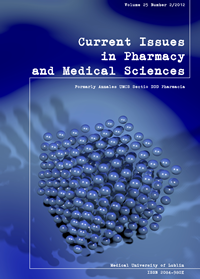Viral safety of blood and its components in modern blood donation – a review
DOI:
https://doi.org/10.12923/j.2084-980X/25.2/a.12Słowa kluczowe:
blood donation, blood treatment, blood-borne infection factors, transfusion medicineAbstrakt
Today, we can observe that blood transfusion is carried out with greater care, which helps to prevent a number of infections in patients. Thus, emphasis is put on non-specific prophylaxis together with regular vaccinations. It is important to stress that blood transfusion is currently developing due to the following proceedings: careful selection of donors, serologic examinations, molecular investigations that check HBV, HCV, HIV, syphilis markers, providing periods for growing plasma and cryoprecipitate, leucoproduction, and common inactivation of patogens in blood components. Nowadays, higher risk of infection can be observed in many non-medical cases (body piercing, tattoos, travelling to hot and exotic countries, regular beauty treatments, etc.). Furthermore, newly selected microorganisms and mutations of popular strains are considered a challenge for contemporary virology, too.
Bibliografia
1. 60 Years of Regional Centre of Blood Donation and Blood Treatment in Poznan (2006). Urban Publisher and Regional Centre of Blood Donation and Blood Treatment in Poznan (in Polish).
2. Safety of blood: risk of infections HIV, HCV, and HBV http://www.pck.pl/archives,695.html (21.07.2011) (in Polish).
3. Brojer E: Analysis of serological and molecular markers of HCV in blood donors in Poland. Przeg. Epidemiol., 59, 511, 2005 (in Polish).
4. Brojer E: Blood-borne infection factors. Oinpharma, Warsaw 2008 (in Polish).
5. Buyx AM: Blood donation, payment, and non-cash incentives: classical questions drawing renewed interest. Transfus. Med. Hemother., 36, 329, 2009.
6. Cervia JS et al.: An overview of prion biology and the role of blood filtration in reducing the risk of transfusion-transmitted variant Creutzfeldt-Jakob disease. Transfus. Med. Rev., 20, 190, 2006.
7. Dzieciątkowska A et al.: Is ALAT activity test helpful in eliminating viral hepatitis carriers from donor population? J. Transfus. Med., 1, 28, 2008 (in Polish).
8. Regulation of the Minister of Health 31 December 2009, Statute book No. 7, pos.50, 2010 (in Polish).
9. Directive 2002/98/EC of the European Parliament and of the Council from 27 January 2003.
10. Directive 2004/33/EC of the European Parliament and of the Council from 22 March 2004.
11. Guide to the preparation, use and quality assurance of blood components. Recommendation No. R (95) 15, 14th Edition, EDQM, 2008.
12. Hożejowski R, Kozłowska B: Viral safety of coagulation factors in the treatment of haemophilia A. Nowa Pediatria, 4, 133, 2010 (in Polish).
13. Korsak T, Łętowska M. et al.: Clinical Transfusiology (2009). α-medica Press (in Polish).
14. Korsak J: Infections of the gastrointestinal system – risk of transmission with blood and blood components Pol. Merk. Lek., 22, 503, 2007 (in Polish).
15. Król D, Drybańska B, Mazur B: Filtration - the most effective leukodepletion method from blood and blood components Acta Haematol. Polon., 36, 399, 2005 (in Polish).
16. Król D, Mazur B, Drybańska B: Characteristic of adverse reactions after blood components transfusion. Przegl. Lek., 66, 453, 2009 (in Polish).
17. The questionnaire for blood donors in Regional Centre of Blood Donation and Blood Treatment in Poznan. Version 14, 02.01.2012
1. http://www.rckik.poznan.pl/documents/links_1.html (2.03.2012) (in Polish)
18. Lachert E, Antoniewicz-Papis J: Methods of pathogen inactivation in blood products J. Transfus. Med., 3, 112, 2010 (in Polish).
19. Lachert E. Pathogen inactivation in blood and blood components. Laboratorium, 4, 54, 2006 (in Polish).
20. Lachert E. Quality assurance blood and blood components in modern blood donation. Laboratorium, 4, 45, 2005 (in Polish).
21. Łętowska M: Medical rules for blood collection, separation of the components and distribution the public force in the organizational units for blood. Institute of Hematology and Transfusiology in Warsaw, 2006 (in Polish).
22. Marciniak-Bielak D: Safety of blood transfusion. Acta Haematol. Polon., 39, 684, 2008 (in Polish).
23. Masse M: Universal leukoreduction of cellular and plasma components: process control and performance of the leukoreduction process. Transfus. Clin. Biol., 8, 297, 2001.
24. Mintz PD: Blood Treatment. Clinical Precept. Publisher of Transfusiology Section of Polish Society of Hematologists and Transfusiologists. Warsaw, 2001, 360-361 (in Polish).
25. Manual of Optimal Blood Use. Support for safe, clinically effective and efficient use of blood in Europe. Scottish National Blood Transfusion Service., 25, 2010 http://www.optimalblooduse.eu/_assets/pdf/manual/polish%20blood%20use%20manual.pdf (2.03.2012) (in Polish).
26. Rock G: A comparison of methods of pathogen inactivation of FFP. Vox Sanguinis, 100, 169, 2011.
27. Rosiek A et al.: Consequences of long-term plasma, platelet and whole blood donating. Acta Haematol. Polon., 37, 75, 2006 (in Polish).
28. Regulation of the Minister of Health 18 April 2005, Statute book No 79, pos. 691, 2005 (in Polish).
29. Regulation of the Minister of Health 9 August 2005, Statute book No 159, pos. 1072, 2010 (in Polish).
30. Rudowska E et al.: The epidemiological trends connected with detection of HIV, HCV, HBV and syphilis markers in blood donors in the years 2006-2009. Pol. Merk. Lek., 30, 181, 2011 (in Polish).
31. Sabliński J, Łętowska M. Blood donation. Book of regulations for medical establishments. Department of Health and Social Security. Institute of Hematology and Transfusiology in Warsaw. 1996 (in Polish).
32. Seyfried H et al.: Analysis of detection infection markers Hepatitis C virus in Polish blood donor in the years 1994-2003. Przegl.Epidemiol., 59, 807, 2005 (in Polish).
33. Szymczyk-Nużka M. Educated donor – safe patient. Pol. Merk. Lek., 30, 208, 2011 (in Polish).
34. The Act of 22 August 1997 of the public service of blood, Statute book No 106, pos. 681, 1997 (in Polish).
35. The self-sufficiency of the Republic of Poland in terms of blood, blood components and blood products. The health programme of the Ministry of health for years 2009-2014. Warsaw, May 2009; http://www.mz.gov.pl/wwwfiles/ma_struktura/docs/prgaram_zdr_14072009.pdf (2.03.2012) (in Polish).
Pobrania
Opublikowane
Numer
Dział
Licencja
Prawa autorskie (c) 2012 Autorzy

Praca jest udostępniana na licencji Creative Commons Attribution-NonCommercial-NoDerivatives 3.0 Unported License.


